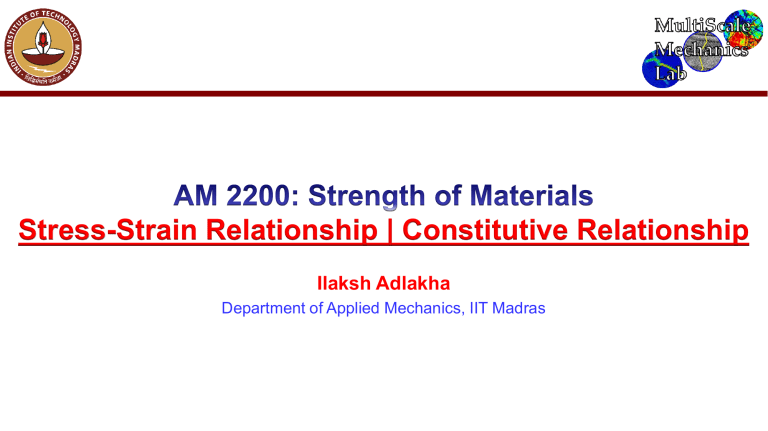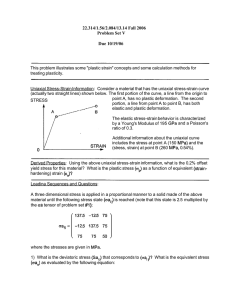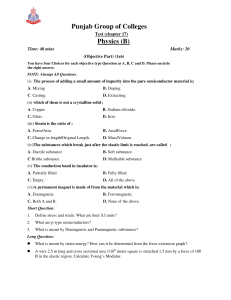
Stress-Strain Relationship | Constitutive Relationship Ilaksh Adlakha Department of Applied Mechanics, IIT Madras Content ❑ Stress-stress relation ❑ Material properties: Young’s modulus; Shear modulus; Bulk modulus; Poisson ratio ❑ Hooke’s Law & Generalized Hooke’s Law ❑ Plane stress and Plane strain AM2200 (July-Nov. 2022), Ilaksh Adlakha ilaksh.adlakha@iitm.ac.in Flow in Mechanics Problem FBD/equilibrium External load Internal forces Strain-deformation Material models/ relations Constitutive relations Stress Strain Deformation Differential equation of equilibrium / governing equations of equilibrium Deformation Strain AM2200 (July-Nov. 2022), Ilaksh Adlakha Stress Internal forces External loads ilaksh.adlakha@iitm.ac.in Stress-Strain in 1D: Normal stress and strain Shear stress and strain AM2200 (July-Nov. 2022), Ilaksh Adlakha ilaksh.adlakha@iitm.ac.in Stress-Strain in 1D: Elastic Constant Young’s Modulus or Modulus of elasticity, E Below the yield stress or within proportionality limit Hooke’s Law Strength is affected by alloying, heat treating, and manufacturing process, but stiffness (Modulus of Elasticity) is not. Stress-strain diagram AM2200 (July-Nov. 2022), Ilaksh Adlakha ilaksh.adlakha@iitm.ac.in Stress-Strain in 1D: Elastic Constant. How? AM2200 (July-Nov. 2022), Ilaksh Adlakha ilaksh.adlakha@iitm.ac.in Tensile test of materials True stress-strain diagram -- Elastic Behavior -- Yielding -- Strain Hardening Nominal/Engg. stress-strain diagram -- Necking Necking Source: Wikipedia AM2200 (July-Nov. 2022), Ilaksh Adlakha ilaksh.adlakha@iitm.ac.in Stress-Strain diagram: Elastic Behavior Elastic Behavior: The material is said to show elastic behavior if the materials returns to its original shape and size once the load is withdrawn. Hooke’s Law Young’s Modulus or Modulus of elasticity, E Below the yield stress or within proportionality limit. Material follows Hooke’s law. Beyond this is plastic behaviour. Proportionality limit: The point in stress-strain graph till which stress is proportional to strain. The material shows linear elastic behavior and follows Hooke’s law. Elastic limit: The point in stress-strain graph till which the material shows elastic behavior. Yielding A slight increase in stress above the elastic limit will result in a breakdown of the material and cause it to deform permanently. This behavior is called yielding. The stress that causes yielding is called the yield stress or yield point.. The upper yield point occurs first, followed by a sudden decrease in load-carrying capacity to a lower yield point. Strength is affected by alloying, heat treating, and manufacturing process but stiffness (Modulus of Elasticity) is not. AM2200 (July-Nov. 2022), Ilaksh Adlakha ilaksh.adlakha@iitm.ac.in Stress-Strain diagram: Plastic behavior Plastic Behavior: The material is said to show plastic behavior if the material does not return to its original shape and size, once the load is withdrawn and leaves a residual strain in the material. Hooke’s law is no more valid for the materials under plastic deformation. The stress-strain; force-deformation relations are nonlinear. Notice that once the yield point is reached, the specimen will continue to elongate (strain) without any increase in load. When the material is in this state, it is often referred to as being perfectly plastic. Strain Hardening: When yielding has ended, an increase in load can be supported by the specimen, resulting in a curve that rises continuously but becomes flatter until it reaches a maximum stress referred to as the ultimate stress. The rise in the curve in this manner is called strain hardening. Necking: Up to the ultimate stress, as the specimen elongates, its cross-sectional area will decrease. This decrease is fairly uniform over the specimen’s entire gauge length; however, just after, at the ultimate stress, the cross-sectional area will begin to decrease in a localized region of the specimen. As a result, a constriction or “neck” tends to form in this region as the specimen elongates further. AM2200 (July-Nov. 2022), Ilaksh Adlakha ilaksh.adlakha@iitm.ac.in True-stress-strain diagram Engineering stress-strain diagram: based on the original geometrical configuration, like cross-sectional area, A0 and gauge length, L0 True stress-strain diagram: based on the actual /deformed geometrical configuration, like instantaneous cross-sectional area, Ai and instantaneous length, Li. AM2200 (July-Nov. 2022), Ilaksh Adlakha ilaksh.adlakha@iitm.ac.in Stress-Strain diagram: 0.2% proof stress Any material that can be subjected to large strains before it fractures is called a ductile material Aluminum, wood, steel It shows cup-cone formation and necking For some materials like, Aluminum, there is NO proper yield point. We calculate yield point based on 0.2% proof stress. AM2200 (July-Nov. 2022), Ilaksh Adlakha ilaksh.adlakha@iitm.ac.in Stress-Strain Diagrams: Al alloy Low-carbon steel Brittle materials AM2200 (July-Nov. 2022), Ilaksh Adlakha ilaksh.adlakha@iitm.ac.in Materials types based on stress-strain diagram Ductile materials: Any material that can be subjected to large strains before it fractures is called a ductile material. Example: Mild steel, Al-, and Mg- alloys. One way to specify the ductility of a material is to look at its percent elongation or percent reduction in area at the time of fracture. The percent elongation is the specimen’s fracture strain expressed as a percent. Engineers often choose ductile materials for design because these materials are capable of absorbing shock or energy, and if they become overloaded, they will usually exhibit large deformation before failing. Brittle material: Materials that exhibit little or no yielding before failure are referred to as brittle materials. Gray cast iron, concrete are examples. Since the appearance of initial cracks in a specimen is quite random, brittle materials do not have a well-defined tensile fracture stress. Brittle materials are good in compression than in tension. AM2200 (July-Nov. 2022), Ilaksh Adlakha ilaksh.adlakha@iitm.ac.in Stress-Strain diagram: Compression Materials that exhibit little or no yielding before failure are referred to as brittle materials. Cast iron, Concrete. Not suited for tensile stresses but are very good COMPRESSION materials Stress-strain diagram of concrete J. of Advanced Research in Applied Mechanics: 2289-7895 | Vol. 22, No. 1. Pages 13-48, 2016 AM2200 (July-Nov. 2022), Ilaksh Adlakha ilaksh.adlakha@iitm.ac.in Strain Energy AM2200 (July-Nov. 2022), Ilaksh Adlakha ilaksh.adlakha@iitm.ac.in Modulus of Resilience and Toughness Modulus of Resilience: The strain energy when the stress reaches the proportional limit. Physically a material’s resilience represents the ability of the material to absorb energy without any permanent damage to the material. Modulus of Toughness: This quantity represents the entire area under the stress–strain. It indicates the strain-energy density of the material just before it fractures. This property becomes important when designing members that may be accidentally overloaded. AM2200 (July-Nov. 2022), Ilaksh Adlakha ilaksh.adlakha@iitm.ac.in Problem 01 The stress-strain diagram for an Al alloy that is used for making aircraft parts in Figure. If the material was stressed to 600 MPa. Determine the permanent strain that remains in the specimen when the stress is released. Find the modulus of resilience both at points A and B. AM2200 (July-Nov. 2022), Ilaksh Adlakha ilaksh.adlakha@iitm.ac.in Problem 01 The stress-strain diagram for an Al alloy that is used for making aircraft parts in Figure. If the material was stressed to 600 MPa. Determine the permanent strain that remains in the specimen when the stress is released. Find the modulus of resilience both at points A and B. AM2200 (July-Nov. 2022), Ilaksh Adlakha ilaksh.adlakha@iitm.ac.in Stress-Strain diagram: strain hardening Stress-strain diagrams portray the behavior of engineering materials when the materials are loaded in tension or compression, as described in the preceding section. To go one step further, let us now consider what happens when the load is removed, and the material is unloaded. The property of a material, by which it returns to its original dimensions during unloading, is called elasticity. Note that the stress-strain curve from O to A need not be linear in order for the material to be elastic. AM2200 (July-Nov. 2022), Ilaksh Adlakha The unloading line is parallel to the tangent to the stressstrain curve at the origin. A permanent set is observed as a residual strain, or permanent strain, remains in the material. Thus, during unloading the bar returns partially to its original shape, and so the material is said to be partially elastic. ilaksh.adlakha@iitm.ac.in problem. Rigid Materials: A(ii) rigid material i.e strain hardening is depicted in the figure below: A perfectly plastic i.e non-strain hardening material is plastic shown below: Material Classification:It isStress-Strain the one which donot experience anydiagrams strain regardless of the applied stress. (i) Linear elastic material: A linear elastic material is one in which the strain is proportional to stress as shown below: A perfectly plastic i.e non-strain hardening material is shown below: (v) Elastic Perfectly Plastic material: (iv) Rigid Plastic material(strain hardening): Linear elastic model Rigid material model (iii)elastic Perfectly plastic(non-strain hardening): There are also other types of idealized models of material behavior. The perfectly plastic material is having the A rigid plastic material i.e strain hardening is depicted in the figure below: (ii) Rigid Materials: It is the one which donot experience any strain regardless of the applied stress. Rigid plastic model (Strain hardening) (iii) Perfectly plastic(non-strain hardening): (v) Elastic Perfectly Plastic material: Plastic model (iv) Rigid Plasticmaterial material(strain hardening): characteristics as shown below: A rigid plastic material i.e strain hardening is depicted in the figure belo Elastic-perfectly plastic Elastic plastic model (vi) Elastic model– Plastic material: (v) Elastic Perfectly Plastic material: Elastic Stress – strain Relations : The elastic perfectly plastic material is having the characteristics as shown below: The elastic plastic material exhibits a stress Vs strain diagram as material depictedis in the figure The elastic perfectly plastic having the characteristics as show below: Previously stress – strain relations were consider AM2200 (July-Nov. 2022), Ilaksh Adlakha ilaksh.adlakha@iitm.ac.in Shear stress-strain in 1D: Shear Modulus/ Modulus of Rigidity Material under pure shear shows a linear relation between shear strain and shear stress. The constant of proportionality is called Shear Modulus or Modulus of Rigidity 𝐸 2(1 + 𝜈) For uniform shear stress/strain distribution, the material is assumed homogeneous and isotropic. 𝐺= AM2200 (July-Nov. 2022), Ilaksh Adlakha ilaksh.adlakha@iitm.ac.in Poisson Ratio: It has been observed that for an elastic materials, the lateral strain is proportional to the longitudinal strain. The ratio of the lateral strain to longitudinal strain is known as the Poisson's ratio. Poisson’s Ratio Poisson’s ratio is a dimensionless quantity that has a value between 0 and 0.5 for most materials, although some composite 1 materials can have negative values for 𝜈. The theoretical range for Poisson’s ration is –1 ≤ 𝝂 ≤ 0.5. AM2200 (July-Nov. 2022), Ilaksh Adlakha ilaksh.adlakha@iitm.ac.in Generalized Hooke’s Law: AM2200 (July-Nov. 2022), Ilaksh Adlakha ilaksh.adlakha@iitm.ac.in Generalized Hooke’s Law: The use of Poisson’s ratio to relate strains in perpendicular directions is valid not only for Cartesian coordinates but for any orthogonal coordinate system. Thus the generalized Hooke’s law may be written for any orthogonal coordinate system, such as spherical and polar coordinate systems. AM2200 (July-Nov. 2022), Ilaksh Adlakha ilaksh.adlakha@iitm.ac.in Bulk modulus | Dilatation The constant k is known as the bulk modulus of the material. AM2200 (July-Nov. 2022), Ilaksh Adlakha ilaksh.adlakha@iitm.ac.in Problem 02 A circle of diameter, d = 9 in. is scribed on an unstressed Al plate of thickness, t = ¾ in. The plate is subjected to normal stress along X and Z directions of 12 and 20 ksi, respectively. E for Al = 10 x 106 psi and 𝜈= 1/3. Determine the change: a) AB b) CD c) Thickness of plate d) Volume of plate AM2200 (July-Nov. 2022), Ilaksh Adlakha ilaksh.adlakha@iitm.ac.in Plane Strain AM2200 (July-Nov. 2022), Ilaksh Adlakha ilaksh.adlakha@iitm.ac.in Plane Stress State of stress AM2200 (July-Nov. 2022), Ilaksh Adlakha State of strain ilaksh.adlakha@iitm.ac.in Problem 03 The stresses at a point on steel were found to be σxx = 15 MPa (T), σyy = 30 MPa (C), and 𝜏𝑥𝑦 = 25 MPa. Using E = 210 GPA and 𝜈 = 0.25, determine the state of strains εxx , εyy, γxy, εzz and the stress σzz assuming (a) the point is in a state of plane stress. (b) the point is in a state of plane strain. AM2200 (July-Nov. 2022), Ilaksh Adlakha ilaksh.adlakha@iitm.ac.in






